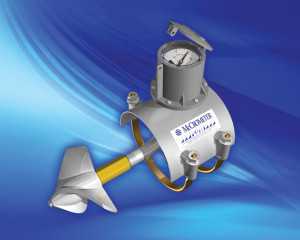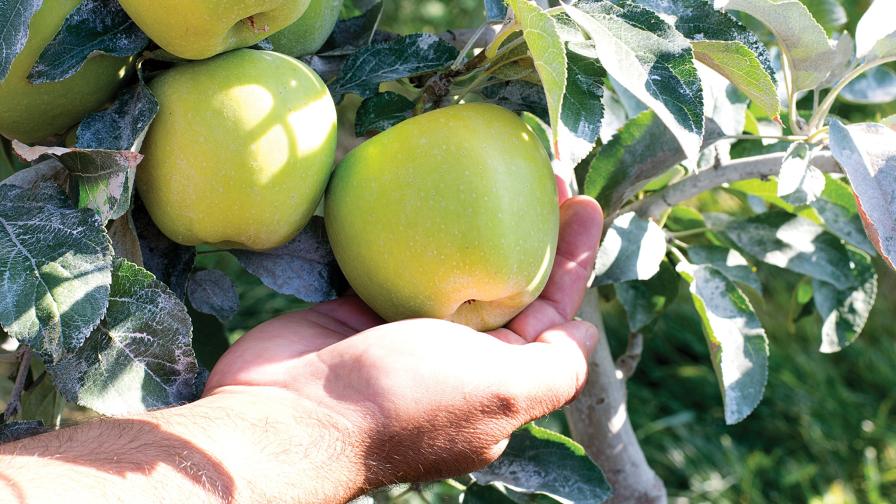Tracking Frost Protection With Monitoring System
 Editor’s Note: This story was written on behalf of McCrometer CONNECT.
Editor’s Note: This story was written on behalf of McCrometer CONNECT.
THE 400-acre Briggs and Eggers Orchards in the fertile Bonita Springs Valley of southern Arizona has been growing apples, peaches, and pears since 1968. Owners Lance and Melissa Eggers and Joe and Jean Briggs have been committed to building a strong program with sustainable environmental practices since 1990.
Granite-rich alluvial soil and moderate, high-elevation Arizona summers allow early harvests of Gala, Red Delicious, and Pink Lady. The fruit is sold in stores throughout the U.S. and Canada under the brand name “Briggs & Eggers and Patagonia Orchards.”
Briggs and Eggers Orchards is located at an elevation of 4,500 feet. In the spring, sunny days and cool, cloudless nights bring the threat of radiative cooling and sharp temperature drops. A significant challenge the farm faces is providing frost protection during critical growing stages.
Briggs and Eggers Orchards set up a McCrometer CONNECT network in 1993 to track critical low temperatures with three weather stations. The farm owners have continued to add stations and sensors over the years and now have a total of 24 agronomic, irrigation scheduling, and water monitoring stations.
The initial Briggs and Eggers frost monitoring system was composed of three solar-powered MINI-SSR Field Stations and a central base station. Situated with a clear line of sight at select locations in the orchard, the three radio stations were equipped with temperature and relative humidity sensors to gather site-specific weather data such as ambient temperature, dew point, and wet bulb temperatures. These stations transmit the data via spread spectrum back to the MINI-SSR BASE Station in the farm’s office.
When first installed 20 years ago, the system used a local PC with a base station attached that ran the Field Vision Software, complete with Pager and Wet Bulb/Dew Point modules. Later, as technology evolved, a server was added to allow online access to the data and for advanced alarm capability. Today, farm operators have the ability to view the data anytime from any location, via smart phone, tablet, or PC.
In The Field
Briggs and Eggers use the data gathered from their McCrometer CONNECT monitoring system for frost risk assessment and protection planning. Reported conditions at each station location identify for managers which of the farm’s 39 wind machines to activate for frost protection and helps them determine when it is safe to turn them off. The data also allows managers to assess potential damage to crops by tracking severity of chill conditions and length of duration.
An essential feature of the frost monitoring system is an integrated alarm capability. There are two ways Briggs & Eggers Orchards can set the field stations to alert them of critical temperature conditions.
The first way is by programming a critical temperature level into each of the field stations to initiate an immediate report when the temperature reaches that threshold. Secondly, the field station can look for a severe drop in temperature.
If the temperature drops more than a set point since the last reading, the station will send an immediate notice back to the base station. The base station software then transmits the frost alarm to the farm operators who then can immediately take protective measures. Originally, a dial-out modem was used to send alerts to a pager. Advances today allow alerts to be received via e-mail, SMS, or text to voice messages.
Minimizing the effects of frost damage to new spring growth is critical to ensuring quality fruit and highest yield. Within its first year of use, the weather monitoring system proved so effective in helping Briggs and Eggers avoid loss of crop to frost that the system paid for itself.
“The McCrometer CONNECT products are reliable, easy to use, and provide vital frost data that helps us protect our fruit. The alternative is driving a truck all night long to check 20 separate locations. Last year during a severe freeze, we were able to minimize damage to 20% of our crop. Our neighbors without this type of system lost 80% of their crop. The investment is well worth it,” Lance Eggers said.
As farm operations have grown and their needs have evolved over the years, Briggs and Eggers Orchards have continued to add more field stations and sensors to their flexible network. To help with irrigation scheduling, soil moisture monitoring components were integrated into the network to give managers valuable information into how much water is being delivered, and to what depth. Operators use the information to adjust irrigation schedules to best meet the needs of the different fruit trees throughout the microclimates and varied topography in the various orchards.
“While I haven’t quantified the exact dollar value of the system’s benefit, I know there are cost savings in terms of staff time in responding to potential frost conditions and by not over-watering, which reduces our water costs,” says Lance Eggers. “The benefits of the system are more qualitative. Knowing what is going on at all times gives me the ability to take the right action at the right time. Information is available wherever I am: in the field, in the office, or completely away from the orchard.”
Maintaining Water Flow
For its water source, Briggs and Eggers Orchards relies on five wells, each ranging from 650 to 1,000 feet deep. For proper irrigation, the water flow rate must be maintained continuously during each cycle, which can be a real challenge when drawing from wells of such varying depths. Fluctuations in water levels and pump performance require constant adjustment to maintain a regular output day to day and over the course of the season.
To help monitor these variables, McCrometer McPropeller Flow Meters were installed on each of the five wells. These rugged, self–cleaning MO300 Series meters with shielded bearings are designed to reliably operate in dirty water environments where sediment and particles can otherwise affect performance. The meters accurately measure total volume pumped and the flow rate. This information is manually gathered from the meters and used to coordinate pump operations for maximum efficiency and flow consistency.
With plans to integrate the flow meters into their wireless network, Briggs and Eggers will gain the convenience of remote meter reading capability. This can easily be achieved by adding a pulse transmitter and a Nano-SSR Field Station to each of the existing meters. Managers can then remotely view the flow meter data via the Internet, saving the staff time and resources required for manual readings.
Another versatile feature that can be adopted at any time is the system’s Supervisory Control and Data Acquisition (SCADA) capability. Should Briggs and Eggers choose to implement automatic on/off control of valves or the frost fans, for example, the MINI-SS station’s user programmable features can be set to handle the task.










